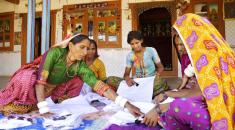Research and Curation

The Research and Curation team at the Canadian Museum for Human Rights is comprised of experts in the fields of Canadian and international human rights. Their work is focused on the development of content to support the Museum’s exhibitions and programming, which includes an emphasis on oral histories. The Research and Curation team is also engaged in academic and publicly oriented scholarship.
How do you deal with difficult subject matter?
The meaning of “difficult” is subjective. In our work, the term “difficult” is used to describe human rights stories that have different—and sometimes conflicting—perspectives. In order to examine these topics, research is based on credible, critical scholarship, and care is taken to ensure a balanced approach is maintained. Our primary goal is always to encourage dialogue and reflection on human rights issues through rigorous and scholarly research.
Issues such as genocide, violence, and other kinds of human rights abuses are often difficult to study, but it is only in confronting the reality of such subjects that change can occur. In studying these issues, we seek to understand how and why things happen. This analytical approach ensures that our scholarship on human rights is relevant to the present and the future, emphasizing the need for ongoing awareness, vigilance and action.
What is the best part about being a researcher?
Although each team member brings a unique perspective and distinct expertise to the research process, researchers work as part of a collaborative, interdisciplinary team. Our work allows us to study a variety of human rights issues from Canada and around the world. We also study artifacts, conduct oral histories and analyze historical and contemporary documents. We have a rich and engaging environment in which to study human rights.
Perhaps the most rewarding part about being a researcher comes through working collaboratively with individuals and communities whose stories the Museum features. We have the opportunity to learn firsthand the experiences of peoples who have survived gross human rights violations, have taken action to promote and defend human rights, or have had their lives affected by the struggle for equality, respect, and justice. We have a commitment and a responsibility to share these stories in a way that promotes positive change.
What is your research methodology?
The Museum values scholarship that is rigorous, engaged and relevant. Researchers at the Museum hold graduate degrees in many disciplines, including history, political science, film studies, genocide studies, law, and Indigenous studies, and provide subject matter expertise on a variety of human rights topics. In developing content for exhibits and programs, we seek methods that are collaborative, respectful, inclusive and participatory.
Researchers draw on a variety of sources, including:
- oral histories
- archival documents
- photographs
- social media
- film
- digital collections
- scholarly articles
- published works.
As researchers, we examine and assess different perspectives on a particular topic. These multiple inputs allow us to form hypotheses that identify relationships between historical and contemporary events, and they also help us to understand human rights in broad cultural and political contexts. Through rigorous selection, organization, and critical analysis of evidence, we strive to draw meaningful and thought-provoking conclusions.
What does a researcher do?
One of the primary roles of a Museum researcher is to provide subject matter expertise and content direction for Museum exhibitions. We also work closely with other departments, to support Museum programming and activities.. We conduct oral history interviews with a wide range of people, including human rights defenders, scholars, and survivors of human rights abuses. In addition to providing stories for exhibits and programs, these oral histories also form an important part of the Museum’s collections.
The role of a researcher often extends beyond the physical Museum. We are engaged in a variety of collaborative, community-based projects, and we disseminate our work through many different means. In addition to giving presentations at conferences and providing guest lectures to community groups and university classes, we publish books, articles, blogs, and other research findings in print and online.










